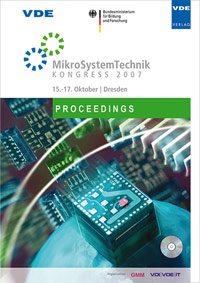Characterization of the DRIE Fabrication of Cell-Penetrating Microneedles
Conference: MikroSystemTechnik - KONGRESS 2007
10/15/2007 - 10/17/2007 at Dresden, Germany
Proceedings: MikroSystemTechnik
Pages: 4Language: englishTyp: PDF
Personal VDE Members are entitled to a 10% discount on this title
Authors:
Held, Jochen; Gaspar, Joao; Ruther, Patrick; Paul, Oliver (Microsystem Materials Laboratory, Department of Microsystems Engineering (IMTEK), University of Freiburg, Germany)
Abstract:
This paper reports on the systematic characterization of a previously developed fabrication process of microneedles based on deep reactive ion etching (DRIE) of silicon. The possibility of using such needles as protruding microelectrodes able to penetrate individual living cells, and thus providing an access channel to electrochemical signals within the cells, motivates the systematic analysis of the influence of the relevant etching parameters on the needle shape. The etching of the needle is performed in three steps: an isotropic, then one anisotropic and finally an isotropic etch step. The first isotropic step defines the tip of the needle, the anisotropic etching step serves to increase its height and the final isotropic step thins the microneedle and sharpens the tip. For this etch sequence 13 process parameters, such as etching and passivation times, platen power and SF6 and C4F8 flows at the different etching steps, are varied in a systematic way. The resulting geometry of the fabricated structures is obtained from the analysis of scanning electron micrographs (SEM) micrographs. Needles with diameters as low as 1 µm with heights as high as 10 µm are obtained. The analysis of the dominant etch parameters on the geometry of the microneedles is based on Design of Experiment (DoE) methodology. The needle dimensional dependences on process inputs are presented and interpolation procedures of the geometry with processing conditions proposed.


